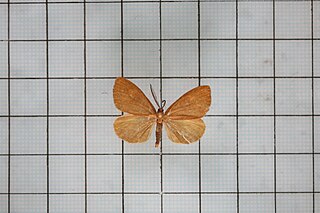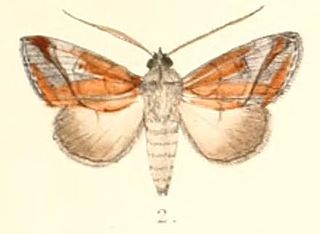
The Sesiidae or clearwing moths are a diurnal moth family in the order Lepidoptera known for their Batesian mimicry in both appearance and behaviour of various Hymenoptera.
William Stephen Atkinson was a British lepidopterist who worked for much of his life in India.

Adrepsa is a genus of moths in the subfamily Arctiinae first described by Frederic Moore in 1879.

Coarica is a monotypic moth genus of the family Noctuidae. Its only species, Coarica fasciata, is known from India, Thailand and China. Both the genus and species were first described by Frederic Moore in 1882.

Itmaharela is a genus of moths of the family Noctuidae.

Nikara is a genus of moths of the family Noctuidae described by Frederic Moore in 1882.

Talapoptera is a monotypic moth genus of the family Erebidae erected by George Hampson in 1926.

Baorisa hieroglyphica, also known as the Picasso moth, is a species of moth in the family Erebidae. It was described by the British entomologist Frederic Moore in 1882. The genus Baorisa was long thought to be monotypic, but three other species have been described. It is found in parts of northeastern India and Southeast Asia.

Sypnoides pannosa is a species of moth of the family Erebidae first described by Frederic Moore in 1882. It is found in India, the Himalayas, Borneo, Sumatra, Thailand and Taiwan.

Arbudas is a genus of moths in the family Zygaenidae.

Risoba vitellina is a species of moth of the family Nolidae first described by Frederic Moore in 1882. It is found in India.

Risoba variegata is a species of moth of the family Nolidae first described by Frederic Moore in 1882. It is found in India.

Risoba basalis is a species of moth of the family Nolidae first described by Frederic Moore in 1882.

Phlogophora calamistrata is a species of moth of the family Noctuidae first described by Frederic Moore in 1882. It is found in India.

Ugia transversa is a species of moth in the family Erebidae first described by Frederic Moore in 1882. It is found from the north-eastern Himalayas to southern China.
Autoba angulifera is a species of moth of the family Erebidae first described by Frederic Moore in 1882. It is found in India.

Autoba obscura is a species of moth of the family Erebidae first described by Frederic Moore in 1882. It is found in India.

Euphiuche picta is a species of moth of the family Noctuidae first described by Frederic Moore in 1882. It is known from India, Thailand, Peninsular Malaysia, Sumatra, Java, Borneo and Sulawesi.

Ginshachia is a genus of moths belonging to the family Notodontidae.
















